 |
 |
 |
 |
 |
 |
2004 Pinx Cup: Kimchi Power!
The Pinx Cup is quickly becoming a rivalry of intense proportions. It started in 1999 as a friendly competition at the end of the year between the women golfers of Japan and those of South Korea. At the time, Japan was known as more of a golf powerhouse, with the bigger domestic tour and more international success. But the tide was already beginning to turn in favor of Korea. By 1999, they already had a young superstar named Se Ri Pak who had turned the LPGA on its ear in her first two years with 8 victories, including two Majors; and the reigning Rookie of the Year, Mi Hyun Kim. Still, two players do not a team make, and as expected, the Japanese won that first Pinx Cup. They would repeat in 2000, despite the presence of Se Ri Pak, because, again, they were simply a deeper team. Grace Park had just had her rookie season, and several other promising newcomers, such as Jeong Jang and Gloria Park, made small waves on the American tour that year. But all in all, the Korean wave had not yet gained steam.
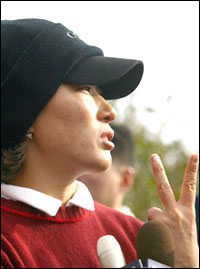
Se Ri flashes the Victory sign
after the Koreans won the Cup last year
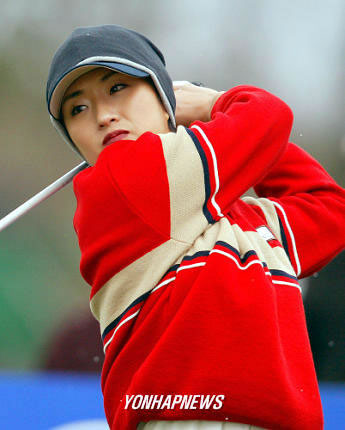
Grace at last year's Pinx Cup
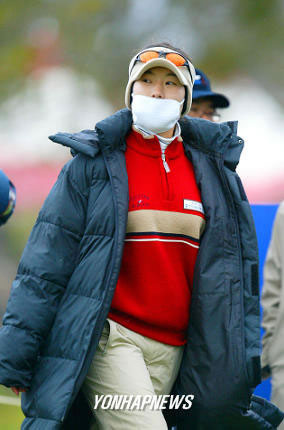
Who is that masked woman? Shi Hyun Ahn,
who played her first Pinx Cup last year
What a difference two years can make! The event was not held in 2001. In 2002, it was temporarily renamed the Maruhan Cup when a new sponsor stepped in for Pinx (Pinx would return as the sponsor in 2003). In the intervening two years, Korean golf had become a phenomenon overwhelming the women's game. Suddenly, instead of just one or two top young players, there were literally seven or eight world class Korean players. Tired of losing to the Japanese, they sent every gun they could muster to the third Pinx Cup, intent on finally winning one of these things. The tide had turned, and the Korean women, in rather miserable weather, routed the Japanese 30-18, on Japanese soil, yet. They joyously sang Christmas carols as they watched each of their teammates finish on the 18th hole on Sunday. They weren't the underdogs anymore.
Much the same thing happened in 2003, this time on Cheju Island in Korea. Again, the weather was horrendous, with wind and snow (!) to contend with. And again, the Koreans sent a superstar team. By now they were a full 8 players deep, and that overwhelming talent was too much for the Japanese. Another win, and the series was tied at 2 apiece.
The Korean wave has continued unabated in 2004. If anything, they have even more talented players to tap for their team than in 2003. Among the newcomers are Shi Hyun Ahn, who played in 2003, but really came into her own as a force in 2004; Aree Song, who turned pro at the end of 2003 and finished in the top 30 on the LPGA money list; and Christina Kim, herself only 20, with an LPGA win and a top 20 money list finish in 2004. The Koreans were so deep that they were able to leave solid players like Gloria Park, Jung Yeon Lee and Soo Yun Kang on the sidelines in favor of the players they did send. Even though there were a few issues (Se Ri Pak having a lackluster year, for instance), these were offset by many strengths (Jeong Jang, Ahn and Christina Kim having career years; Mi Hyun Kim playing better than 2003; Grace Park's ascendance). And heck, even a lackluster Se Ri Pak was still a major force to be reckoned with. It would seem as though the advantage was still Korea's.
But Japan had experienced a small renaissance in women's golf themselves, led by two young players. One was a teenager named Yokomine Sakura, who had been quietly making a name for herself on the JLPGA. But more significant was the explosive arrival of a prodigy named Ai Miyazato. Miyazato had become the youngest player in history to win on the JLPGA when she managed the feat as a tender 18 year old. In 2004, she won 5 times on tour, and had become such a celebrity that she was flooded with endorsements and followed by huge galleries everywhere she went. In the previous month's Mizuno Classic, an LPGA event co-sanctioned by the JLPGA tour, she had managed a second place finish with a final round 63 (and it would have been a 61 except for a two stroke penalty called for a rules infraction). No doubt about it, the Japanese ladies were on the upswing.
Both teams were determined to win the tiebreaker event and take the lead in the overall series. In the days leading up to the fracas, Se Ri Pak, not usually one to talk smack, said in a newspaper interview that she and the other Korean girls were going to go all out to win the event, and felt like losing was not an option. Yuri Fudoh, the top Japanese player, in turn released her own statements about how confident her team was that they could take down the Koreans on home soil. The intensity for this event had been building, until this year, when the rivalry had become an explosive one. As good as they are, the Korean women would not have an easy time of it winning in Japan.
The event took place at the Otsu Country Club in Japan on December 4th and 5th. The Pinx Cup is divided into two sections: on day one, the 12 players from each team are paired into match play competitions. On day 2, the 12 ladies are re-paired and play stroke play matches, where the player with the lowest overall score wins the match. A win is worth 2 points, a tie 1 point.
In the past two years, the Koreans had established a big lead after day one and were uncatchable after that. The Japanese players knew they needed to win or stay close on day one to have any chance of beating the Koreans in stroke play. The Koreans did have one major weakness on Saturday: their currently hottest player, Grace Park, would not be there. Due to previous sponsor commitments in Hong Kong, she would not be able to arrive until the second day. Her place was taken by a relatively unknown Korean LPGA player named Young Mi Lee. Losing a big gun like Grace for one day would be hard enough, but who knew how she would play when she arrived on Sunday, jet lagged, without ever having played the course before? Compounding their worries was the fact that the slumping Se Ri Pak had a wrist injury that hampered her still further. But, trooper that she is, she wouldn't have missed her match for anything.
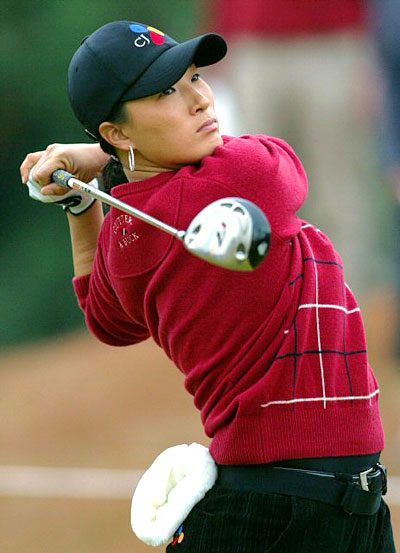
Se Ri during round 1 this year
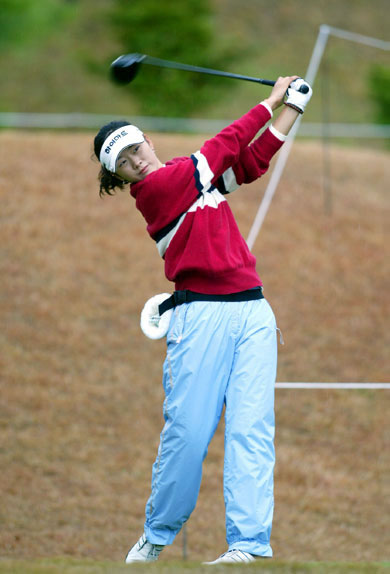
One player thrown into the fire was Hyun Hee Moon,
who not only played in place of Grace Park, but
had to take on one of Japan's top guns

Jeong Jang was the star of round 1
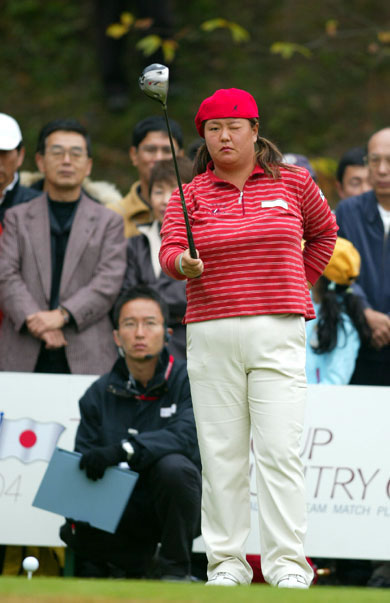
Christina Kim tied on day one
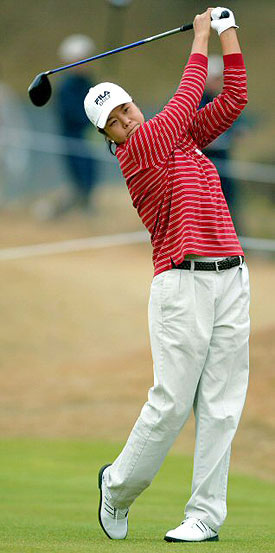
Hee-Won Han was a rock in round one,
picking up the banner for the
Seoul Sisters as the only one
of the Big Four to win Saturday
Se Ri Pak has been the leading point winner for the Korean team in Pinx Cup history. In fact, she had never lost a match until 2003, when she lost the match play matchup. Of course, that happened partly due to circumstances beyond her control. They used local caddies for the event, and Se Ri's caddie had not counted her clubs before tee off. As a result, Se Ri had 15 clubs in her bag, a fact not discovered until the fifth tee. In match play, if you have more than 14 clubs in your bag, you automatically lose each hole you played with that "advantage". Se Ri went from being tied with her opponent to being four down instantly. Although she made a run and kept it close, she still lost her first Pinx Cup match that day.
This year, though, Se Ri lost fair and square, and it was part of a general slump for the Korean top guns that affected their standing after day one. Perhaps her wrist affected her more than she would care to admit, but Se Ri lost to an unheralded Japanese player named Hiromi Mogi 4 and 3. Of course, it didn't help that Se Ri hit two drives out of bounds, on holes 4 and 11. Her driver was acting up yet again, and on Sunday she would deal with that by hitting 3 wood off the tee all day.
Despite Se Ri's struggles, however, the Koreans got off to a pretty good start on Saturday. Young Korean star Bo Bae Song, sort of the Korean version of Ai Miyazato, did her part by winning the opening match. But Akiko Fukushima beat Young Mi Lee easily to tie things up. Jeong Jang, who has been having a great season, then decimated her opponent Shiho Ohyama 6 and 5. It was the most convincing victory of the day, and helped the Koreans regain the lead. Christina Kim kept the faith by squaring her match. The score was now 5-3 for Korea, and Woo Soon Ko made it 7-3 with her own win.
But the next match featured teen swinger Ai Miyazato against one of the Korean team's least known players, Hyun Hee Moon. Moon bravely opined in the press before the match that she would do her best, and would win some of the gallery over to her side as a result. Good luck! The gallery was unashamedly partisan and by far the biggest of the day. Indeed, I would say it was around a thousand fans, easily the biggest gallery I have witnessed in three years of watching the Pinx Cup. They were there for one reason: to watch the teen sensation bring home the bacon for Japan, and she did not disappoint. She beat the overmatched (and probably overwhelmed) Moon somewhat easily, 3 and 1.
So at this point, Korea held a one point lead over Japan, 7-6. But now the top guns of the Korean team - Se Ri Pak, Mi Hyun Kim, Hee-Won Han and Shi Hyun Ahn - were coming to their last holes. Surely the tide was about to turn for Korea?
Alas, it did not. Shi Hyun Ahn found herself in the final group of the day, but dealing with the other teen sensation from Japan, Yokomine Sakura. And Sakura just manhandled Ahn. Their match was quickly over, 6 and 5. Se Ri, as we already mentioned, also lost her match, and Michiko Hattori, one of Japan's stronger players, beat the Korean who plays on the JLPGA tour, Jee Hee Lee. Suddenly, Japan took the lead 11-7.
Fortunately for the Koreans, the other two top players were playing well. Hee-Won Han in particular was doing quite nicely against Japan's top player, Yuri Fudoh. By the time they reached the start of the broadcast, she had gathered a three hole lead, and on the 15th hole, she hit her drive straight while Fudoh went into the trees. Hee-Won did not hit the green with her approach, but Fudoh hit the trees with hers, and Han easily won the hole to finish Fudoh off and gain Korea 2 much needed points.
The last two matches of the day were both nail biters. On the 17th hole, Mi Hyun Kim and Kasumi Fujii were all square. This was a 162 yard par 3. Kimmie missed the green, but put her chip to inches. Easy par. Fujii was on the green, but about 40 feet from the hole. But wouldn't you know it, Fujii dunked the improbable putt to take a 1 up lead with one hole to go. Hoo boy! The weather by now was rainy, but certainly not as bad as it had been the past few years at this event. Kimmie had one more shot to tie the match on 18 when Fujii missed a birdie putt from 30 feet. But Mi Hyun had her own 25 footer, and left that one three feet past the hole. Fujii then made the short par putt and won the match. This was a heartbreaker for the Koreans, and gave the Japanese a 13-9 lead.
It all came down to the youngest player on the Korean squad, Aree Song. She had a one up lead on Mikiyo Nizizuka. A win would get the Koreans to within 2 points, a deficit, but not a bad one. Aree insured herself of at least a point by retaining her lead through 18, but she had had about a 6 foot putt for the win on 17 and just missed it. That would prove to be fatal. On 18, Aree got herself within 20 feet on the green, while her opponent left herself a good 70 feet short. But wouldn't you know it, Nizizuka made the almost unbelievable birdie putt to grab the tie.
So, after the first day, the Korean ladies found themselves in a rare situation: trailing. The Japanese ladies had a 14-10 lead, and Korea needed to regroup. Could they do it?
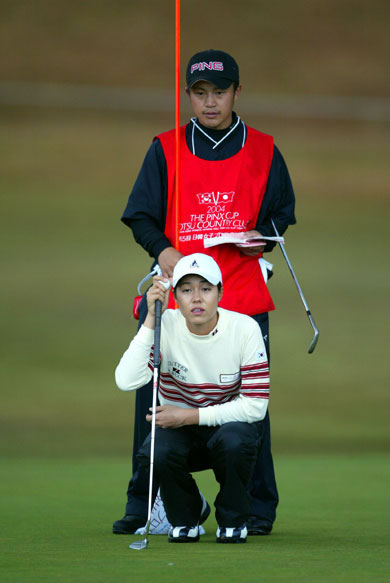
Aree on Saturday was the last player to finish